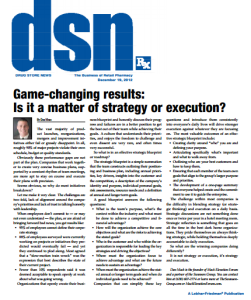Game-changing results: Is it a matter of strategy or execution?
The vast majority of product launches, reorganizations, mergers and improvement initiatives either fail or grossly disappoint. In all, roughly 90% of major projects violate their own schedule, budget or quality standards.
Obviously these performance gaps are not part of the plan. Companies that work together to create very concise business plans, supported by a constant rhythm of team meetings, are more apt to stay on course and execute their plans with precision.
Seems obvious, so why do most initiatives breakdown?
Let me make it very clear. The challenges are two fold, lack of alignment around the company’s priorities and lack of trust in talking honestly with leadership.
When employees don’t commit to — or may not even understand — the plan, or are afraid of bringing forward bad news, you get results like:
- 95% of employees cannot define their corporate strategy.
- 88% of employees surveyed were currently working on projects or initiatives they predicted would eventually fail — and yet they continued to plod along. Most agreed that a “slow-motion train wreck” was the expression that best describes the state of their current project.
- Fewer than 10% respondents said it was deemed acceptable to speak openly at work about what was going wrong. Organizations that openly create their business blueprint and honestly discuss their progress and failures are in a better position to get the best out of their team while achieving their goals. A culture that understands their priorities, and enjoys the freedom to challenge and even dissent are very rare, and often times very successful. So what is in an effective strategic blueprint or roadmap? The strategic blueprint is a simple summation that the team constructs outlining their positioning and business plan, including annual priorities, key drivers, insights into the customer and the competition, a description of the company’s identity and purpose, individual personal goals, risk assessments, resource needs and a definition of annual and longer term goals. A good blueprint answers the following questions:
- What is the team’s purpose, what’s the context within the industry and what must be done to achieve a competitive and financial advantage?
- How will the organization achieve the core objectives and what are the risks to achieving the stated goals?
- Who is the customer and who within the organization is responsible for leading the key strategies and driving the objectives?
- Where must the organization focus to achieve advantage and what are the future needs to sustain an advantage?
- When must the organization achieve the stated annual or longer term goals and when do individual goals need to be achieved? Companies that can simplify these key questions and introduce them consistently into everyone’s daily lives will drive stronger execution against whatever they are focusing on. The most valuable outcomes of an effective strategic blueprint include: • Creating clarity around “who” you are and defining your purpose.
- Articulating specifically what’s important and what to walk away from. • Outlining who are your best customers and how to keep them.
- Ensuring that each member of the team own goals that align to the group’s larger purpose and priorities.
- The development of a one-page summary that everyone helped create and the commitment to use it to guide the enterprise.
The challenge within most companies is the difficulty in blending strategy (or strategic thinking) and execution on a daily basis. Strategic discussions are not something done once or twice per year in a hotel meeting room. Strategic reflection is something that goes on all the time in the best dark horse organizations. They pride themselves on always thinking strategic, while holding themselves deeply accountable to daily execution. So what are the winning companies doing differently? It is not strategy or execution, it’s strategy and execution.[/vc_column_text][/vc_column][/vc_row]


